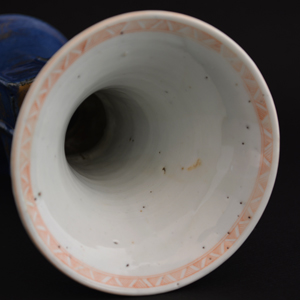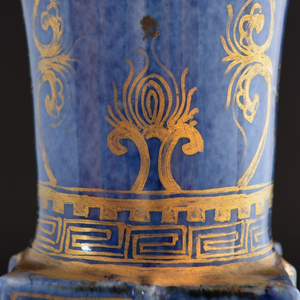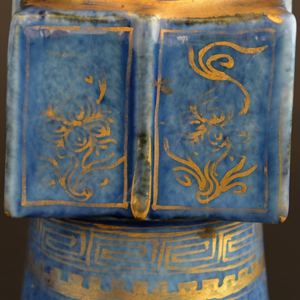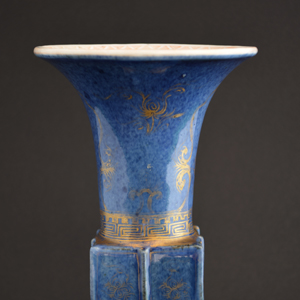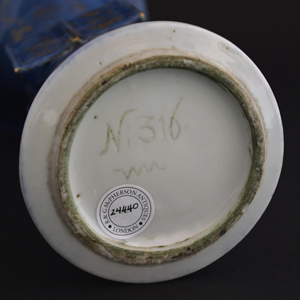
KANGXI 1662 – 1722 From the Collection of Augustus the Strong
A Late Kangxi Powder-Blue Gu Vase c.1720-1722, From the Collection of Augustus II (1670-1733) Acquired in 1723. The Archaic Form of Flared Beaker with a Central Square Section is Gilded with Lappets, Flowers and Borders. The Interior of the Flared Opening is Decorated in Iron Red.
SOLD
- Condition
- No damage, very minor wear to the gilding.
- Size
- Height : 20 cm (8 inches)
- Provenance
- Augustus the Strong (1670 - 1733). The Royal Collection at The Japanese Palace, Dresden, Wheel Engraved Johanneum Inventory Mark to the Base N : 316 with Augustus The Strong : Augustus II (1670-1733) King of Poland and Elector of Saxony known as Augustus the Strong. Augustus`s great physical strength earned him the nicknames `the Strong`, `Saxon Hercules` and `Iron Hand`. He liked to show that he lived up to his name by breaking horse shoes with his bare hands. His ancestor Cymburgis of Masovia was also noted for her strength. Augustus the Strong owed allegiance to the Imperial Habsburgs as a member of the Order of the Golden Fleece. Augustus the Strong owed allegiance to the Imperial Habsburgs as a member of the Order of the Golden Fleece. As Elector of Saxony, he is perhaps best remembered as a patron of the arts and architecture. He established the Saxon capital of Dresden as a major cultural centre, attracting artists and musicians from across Europe to his court. Augustus also amassed an impressive art collection and built fantastic baroque palaces at Dresden and at Warsaw. As a politician, he is nowadays not held in high esteem in Poland, getting blamed for embroiling the Polish-Lithuanian Commonwealth in the Great Northern War. His attempts at internal reforms and at bolstering the royal power are considered to have come to naught, while his policies are said to have allowed the Russian Empire to strengthen its influence over the Polish-Lithuanian Commonwealth. The Japanisches Palais (Japanese Palace) is a Baroque building in Dresden, Germany, on the Neustadt bank of the river Elbe. Built in 1715, it was extended from 1729 until 1731 to store the porcelain collection of Augustus the Strong that is now part of the Dresden Porcelain Collection. However, it was never used for this purpose, and instead served as a library.
- Stock number
- 24440
Information
Augustus The Strong :
Augustus II (1670-1733) King of Poland and Elector of Saxony known as Augustus the Strong. Augustus`s great physical strength earned him the nicknames `the Strong`, `Saxon Hercules` and `Iron Hand`. He liked to show that he lived up to his name by breaking horse shoes with his bare hands. His ancestor Cymburgis of Masovia was also noted for her strength. Augustus the Strong owed allegiance to the Imperial Habsburgs as a member of the Order of the Golden Fleece. Augustus the Strong owed allegiance to the Imperial Habsburgs as a member of the Order of the Golden Fleece. As Elector of Saxony, he is perhaps best remembered as a patron of the arts and architecture. He established the Saxon capital of Dresden as a major cultural centre, attracting artists and musicians from across Europe to his court. Augustus also amassed an impressive art collection and built fantastic baroque palaces at Dresden and at Warsaw. As a politician, he is nowadays not held in high esteem in Poland, getting blamed for embroiling the Polish-Lithuanian Commonwealth in the Great Northern War. His attempts at internal reforms and at bolstering the royal power are considered to have come to naught, while his policies are said to have allowed the Russian Empire to strengthen its influence over the Polish-Lithuanian Commonwealth.
The Japanisches Palais (Japanese Palace) is a Baroque building in Dresden, Germany, on the Neustadt bank of the river Elbe. Built in 1715, it was extended from 1729 until 1731 to store the porcelain collection of Augustus the Strong that is now part of the Dresden Porcelain Collection. However, it was never used for this purpose, and instead served as a library.
Augustus the Strong (1670 - 1733). The Royal Collection at The Japanese Palace, Dresden, Wheel Engraved Johanneum Inventory Mark to the Base N : 316 with VV below. The VV Represents the `Blue and White East India Porcelain section of the inventory, this Gu vase appears to come under Chapter I. Garnitures, Vases, Bottles/Beakers, any Including Garnitures ; Flower pots, Figures etc. N:316 comes from Count Flemming, Bassetouche & Konspruck. Acquired in 1723.
Powder-Blue Decoration :
This type of decoration is associated with the Kangxi period but its origins can be traced to the end of the Ming Dynasty, during the reigns of Tianqi and Chongzhen. Indeed these pieces are a revival of an early Ming technique that seems to have been abandoned or lost at about the time of Xuande. The late Ming examples comprise a group of dishes made at the Jingdezhen kilns during the second quarter of the 17th century. They use an uneven blue ground of a mottled appearance (see `Sold Items` 19206 and 17133), referred to as `Fukizumi` in Japanese they have the characteristics of what we now call powder blue. It was during the Kangxi (1662-1722) that the technique became refined and combined with gilding, Famille Verte or other over-glaze colours. Powder-blue glazes are somewhat different from other Qing blue glazes in that the cobalt was not mixed with the glaze. Instead, it was blown dry onto the biscuit body of the porcelain by using a piece of gauze stretches over the end of a bamboo tube. The result is a somewhat frothy soft effect. Paper or wax resist were used to reserve areas from the blue that could then be decorated after glazing.
